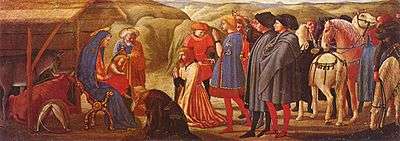Madonna and Child (Masaccio)
 | |
| Artist | Masaccio |
|---|---|
| Year | 1426 |
| Medium | Tempera on Panel |
| Dimensions | 135.5 cm × 75 cm (53.3 in × 30 in) |
| Location | National Gallery, London |
The Madonna and Child with Angels is a painting by the Italian Renaissance painter Masaccio, who worked in collaboration with his brother Giovanni and with Andrea di Giusto.
The painting is the central panel of the Pisa Altarpiece, a large multi-paneled altarpiece executed for the chapel of St. Julian, owned by the notary Giuliano di Colino in the church of Santa Maria del Carmine in Pisa. The painting is in a very damaged state, the altarpiece having been cut up and sold in pieces long ago. Today the panel is smaller than its original state; it has lost perhaps as much as 8 cm. at the bottom and 2-2.5 cm. at each side.[1] Eleven surviving panels of the altarpiece, which is the only documented work by Masaccio, are in various museums.[2] Scholars hypothesize the reconstruction of the altarpiece based on a very complete description by Vasari.[3]
The painting contains six figures: the Madonna and Child and four angels. The Madonna is the centre figure and is larger than any of the others to signify her importance. Christ sits on her knees, eating grapes offered to him by his mother. Although he is an exceedingly babyish baby (in comparison to the babies of Masaccio's immediate predecessors, like Lorenzo Monaco or Gentile da Fabriano), the grapes are a symbol of his blood – like the red wine of Communion – which indicates Christ's awareness of his eventual death. The Madonna looks sorrowfully at her child, as she also realises his fate.

Originally a panel of the Crucifixion stood above this painting, underlining the sacrificial (Eucharistic) nature of the image.[4] In many ways the style of the painting is traditional; the expensive gold background and ultramarine draperies of the Virgin, her enlarged scale, and her hierarchical presentation (ceremoniously enthroned) all fit within the late-medieval formulas for the representation of Mary and Jesus in glory. In other ways, however, the painting is a step away from International Gothic in the sense that Masaccio has created a more realistic approach to the subject:
- The faces are more realistic and not idealised.
- The baby Jesus is less of a small man and more childlike.
- An attempt at creating depth has been attempted by Massacio's placement of the two background angels and through the use of linear perspective in the throne.
- Modeling is clearly visible as the light source is coming from the left of the painting.
- The Madonna is a bulky figure, deriving from classical models, and her drapery has larger and more naturalistic folds that shape her body.

Masaccio has used linear perspective to create pictorial space; it can be seen on the orthogonal on the cornice of her throne. The vanishing point is at the child's foot. The reason for this is that the work was originally located above a representation of the Adoration of the Magi, in which one of the magi kisses Jesus' foot.
Although the paintings are noticeably different (the subjects are clothed differently and on different chairs) the Madonna is more or less in the same position in both works. This parallelism is designed to make viewers have the same attitude as the magus when looking at the Madonna and Child. They are imagined to be kneeling in front of Mary, and could easily lean forward to kiss the foot of Jesus.
Masaccio has also used the overlapping of figures and objects to create pictorial space, like the two angels in the foreground overlapping the throne and the throne overlapping the two angels in the background.
 | |
|
|
Notes
- ↑ Jill Dunkerton and Dillian Gordon, "The Pisa Altarpiece," in Carl Brandon Strehlke, ed.The Panel Paintings of Masolino and Masaccio: The Role of Technique, Milan, 2002, 91–93.
- ↑ Documents published in James Beck, Masaccio: The Documents, Locust Valley, NY, 1978, Appendix, 31–50.
- ↑ Giorgio Vasari, Le vite de' più eccellenti pittori, scultori ed architettori, ed. Gaetano Milanesi, Florence, 1906, II, 292.
- ↑ Jill Dunkerton et al., Giotto to Dürer: Early Renaissance Painting in the National Gallery, New Haven, 1991, 248–251.
- ↑ "Masaccio, Virgin and Child Enthroned". Smarthistory at Khan Academy. Retrieved March 20, 2013.